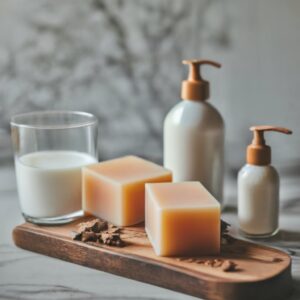
Embark on a journey to discover the beauty secret that has transcended generations – the luxurious elixir of goat milk. Revered for its unparalleled moisturizing and nourishing properties, goat milk stands as a timeless skincare treasure. Enriched with vitamins, minerals, and fats, it transforms your skincare routine into a pampering ritual, offering a multitude of benefits.
In this captivating exploration, we delve into the richness of goat milk, unveiling its ability to provide deep hydration, reduce signs of aging, and soothe even the most sensitive skin. Join us as we uncover the natural wonders of this cherished ingredient, where Vitamin A becomes an anti-aging powerhouse, alpha-hydroxy acids offer radiance, and anti-inflammatory properties bring solace to irritated skin conditions.
Whether you’re seeking a remedy for dryness, aiming to diminish fine lines, or simply yearning for a luminous complexion, goat milk emerges as a holistic and nurturing companion. Embrace the beauty secrets passed down through time and let your skin revel in the pure, unspoiled goodness of goat milk – your gateway to naturally radiant and healthier skin.
goat milk lotion
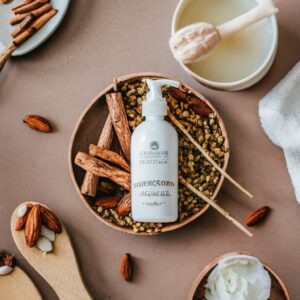
Protect your skin from the winter chill with this exquisite goat milk lotion recipe, a symphony of natural ingredients crafted to provide deep nourishment and protection. Rich in coconut oil and shea butter, infused with the goodness of goat milk, and complemented by the aromatic essence of lavender and bergamot essential oils, this lotion is your gateway to indulgent skincare.
Ingredients for goat milk lotion
- 52.4 g / 2.096 oz Purified water
- 10 g / 0.4 oz Goat milk
- 2 g / 0.09 oz Sodium lactate
- 0.5 g / 0.02 oz Xanthan gum
- 17 g / 0.68 oz Coconut oil
- 6 g / 0.24 oz Shea butter
- 2 g / 0.08 oz Beeswax
- 6 g / 0.24 oz Xyliance
- 2 g / 0.08 oz Cetyl alcohol
- 1 g / 0.04 oz Preservative
- 0.5 g / 0.02 oz / approximately 15 drops of Lavender essential oil
- 0.5 g / 0.02 oz / approximately 15 drops of Bergamot essential oil
- 0.1 g / 0.004 oz / approximately 3 drops of Vitamin E oil
Tools goat milk lotion
- Double Boiler or Saucepan with a Glass Bowl
- Digital Scale
- Mixing Bowl or Half-Gallon Mason Jar
- Immersion Blender
- Kitchen Thermometer
- Lotion Dispenser with Pump or Wide-Mouth Mason Jars with Airtight Lids
Instructions for goat milk lotion
- Prepare the Ingredients:
- Weigh each ingredient using a digital scale for precision.
- Double Boiler Setup:
- Set up a double boiler or place a glass bowl over a saucepan with water. Melt coconut oil, shea butter, and beeswax.
- Combine Ingredients:
- In a mixing bowl or half-gallon mason jar, combine goat’s milk, distilled water, sodium lactate, xanthan gum, Xyliance, and cetyl alcohol.
- Emulsification:
- Slowly add the melted oils to the mixture while using an immersion blender to emulsify. Ensure a smooth and consistent texture.
- Cooling Phase:
- Allow the lotion to cool, checking the temperature with a kitchen thermometer.
- Essential Oils and Antioxidant Boost:
- Add lavender and bergamot essential oils for fragrance and additional skincare benefits. Incorporate Vitamin E oil for its antioxidant properties.
- Preservation:
- Introduce a preservative to ensure the longevity and safety of your lotion.
- Storage:
- Transfer the lotion to a lotion dispenser with a pump or wide-mouth mason jars with airtight lids. Store in a cool, dry place away from direct sunlight.
- Application:
- Apply with clean hands, and revel in the soothing and energizing effects on your skin.
Note for goat milk lotion
- Ingredient Substitutions:
- Sodium lactate can be replaced with glycerin. Experiment with carrier oil substitutions and essential oil variations based on personal preference.
- Shelf Life:
- Approximately six months. Use airless pump dispensers for minimized contamination risk.
Embark on the journey of crafting your own nourishing goat milk lotion, a winter skincare essential that pampers and protects. Enjoy the delightful fusion of natural goodness and aromatic bliss, bringing comfort to your skin during the colder months.
goat milk lotion benefits
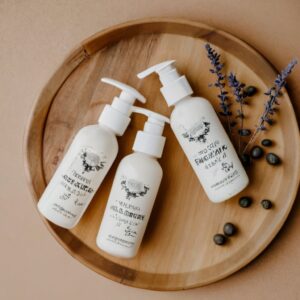
Unleash the power of DIY skincare with goat milk lotion, where every ingredient is a choice made for your skin’s well-being. Crafting your lotion not only puts you in control of the quality but also opens the door to a host of benefits that go beyond what commercial options offer.
1. Quality Control:
- When you make your lotion, you dictate the quality of the ingredients. Many store-bought lotions are laden with synthetic additives, preservatives, and fragrances that can potentially irritate the skin. Opt for organic, high-quality components, steering clear of harmful chemicals for a skincare experience tailored to your needs.
2. Natural and Organic Choices:
- Say goodbye to the mystery of what goes into your skincare. DIY lotions empower you to choose organic and natural ingredients, ensuring that every element contributes to the health and radiance of your skin.
3. Cost-Effectiveness:
- Commercially available natural and organic lotions can be pricey. By crafting your own, you unlock a cost-effective alternative without compromising on quality. Enjoy the luxury of nourishing your skin without breaking the bank.
4. Ingredient Flexibility:
- Tailor your lotion to your skin’s preferences. In this goat’s milk lotion recipe, the flexibility of ingredient choices is yours to explore. From the choice of fat, using shea butter and coconut oil, to options like sweet almond oil, jojoba oil, mango butter, or cocoa butter, the possibilities are abundant.
5. Water Purity:
- The use of distilled or filtered water in DIY lotions ensures purity. Tap water minerals can disrupt the recipe and lead to quicker spoilage. By choosing the right water, you contribute to the longevity and stability of your creation.
6. Thinning for Pump Use:
- Adapting the lotion for use with a pump requires thinning it out with water. This necessitates the introduction of a preservative and an emulsifier, ensuring the lotion remains effective and safe.
7. Trusted Preservative:
- The inclusion of a trusted preservative, such as Geogard ECT from Voyageur Soap and Candle Company, adds reliability to your DIY creation, extending its shelf life without compromising on purity.
TIPS goat milk lotion recipe
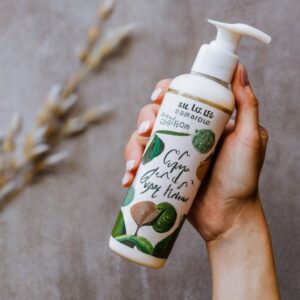
The process of making goat milk lotion may seem intricate, but with the right ingredients and a dash of enthusiasm, it becomes a rewarding endeavor. Let’s demystify the key components and steps involved:
1. Emulsion Magic:
- Lotions are essentially emulsions, a harmonious blend of water and oil. As oil and water naturally resist each other, an emulsifier acts as the bridge, binding these two phases into a stable mixture.
2. Choosing the Right Preservative:
- Due to the water content in lotions, a broad-spectrum preservative becomes crucial to prevent bacterial growth. Consider Preservative Eco (Geogard ECT in the USA, Plantaserv M in Australia) to maintain the integrity of your lotion.
3. Essential Oils for Fragrance and Benefits:
- Elevate your goat milk lotion with the addition of essential oils, not just for fragrance but also for their skincare benefits. Lavender essential oil, known for its calming properties, soothes and relaxes the skin. Tea tree oil, with antimicrobial properties, suits acne-prone skin. Rosemary essential oil, rich in antioxidants, aids in improving the appearance of aging skin.
4. Dilution is Key:
- Essential oils are potent and must be diluted properly to avoid skin irritation. A general guideline is around 10 drops of essential oil per 1 ounce of lotion. Prioritize a patch test before widespread use.
5. Favorite Essential Oils:
- Embrace the aromatic delight of lavender, the timeless essence of frankincense, the soothing charm of chamomile, and the floral elegance of geranium. These oils not only contribute to the fragrance but also bring their unique skincare benefits.
6. Lavender and Bergamot Magic:
- For this goat milk lotion recipe, the captivating duo of lavender and bergamot essential oils takes center stage. Lavender, with its skin-preserving qualities, soothes and heals, making it versatile for various skin types. Bergamot, a skincare gem, promotes healthy skin growth, aids in regeneration, and carries uplifting properties.
7. Essential Oil Safety:
- While lavender is safe for various skin conditions, it’s advisable to avoid during the first trimester of pregnancy. Bergamot, with its healing properties, contributes to emotional well-being and skin health.
goat milk soap recipe
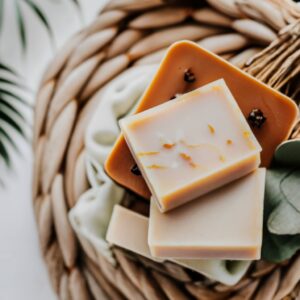
In the realm of skincare, where choices abound and preferences are diverse, one natural gem stands out—the gentle yet mighty goat milk soap. Crafted with care and embraced for centuries, goat milk soap offers a harmonious blend of moisturizing magic, nutrient-rich nourishment, and a touch of nature’s soothing embrace.
This exquisite soap isn’t just a cleansing companion; it’s a holistic experience, a journey into the realms of softness, balance, and skincare simplicity. As we embark on the exploration of the benefits woven into each lather, we’ll uncover why goat milk soap has become a cherished ally for those seeking a natural, skin-friendly indulgence.
Join us in this odyssey through the wonders of goat milk soap—an artisanal creation that transcends mere cleansing, becoming a celebration of skincare crafted with care and brimming with nature’s goodness.
Ingredients for goat milk soap recipe
- Purified Water (52.4 g / 2.096 oz):
- The foundation of hydration, ensuring a refreshing and invigorating lather.
- Goat Milk (10 g / 0.4 oz):
- A natural moisturizer enriched with vitamins and minerals, adding a nourishing touch.
- Sodium Lactate (2 g / 0.09 oz):
- Enhances soap hardness and longevity, contributing to a longer-lasting bar.
- Xanthan Gum (0.5 g / 0.02 oz):
- A natural thickener, providing a rich and creamy texture to the soap.
- Coconut Oil (17 g / 0.68 oz):
- Offers cleansing properties and a lush lather, leaving the skin feeling refreshed.
- Shea Butter (6 g / 0.24 oz):
- Adds moisture and a luxurious feel, promoting skin softness and elasticity.
- Beeswax (2 g / 0.08 oz):
- Provides structure and firmness to the soap, ensuring a durable and long-lasting bar.
- Xyliance (6 g / 0.24 oz):
- A natural emulsifier, facilitating the blending of water and oils for a smooth consistency.
- Cetyl Alcohol (2 g / 0.08 oz):
- Enhances the soap’s stability and texture, contributing to a velvety feel.
- Preservative (1 g / 0.04 oz):
- Ensures the longevity and safety of the soap by preventing microbial growth.
- Lavender Essential Oil (0.5 g / 0.02 oz):
- Infuses a calming and aromatic essence, turning each use into a sensory delight.
- Bergamot Essential Oil (0.5 g / 0.02 oz):
- Adds a citrusy and uplifting note, creating a refreshing and invigorating bathing experience.
- Vitamin E Oil (0.1 g / 0.004 oz):
- Bestows antioxidant benefits, promoting skin health and vitality.
Tools for goat milk soap recipe
- Double Boiler or Saucepan with a Glass Bowl:
- Facilitates gentle melting and blending of ingredients without direct heat exposure.
- Digital Scale:
- Ensures precise measurements for a balanced and effective soap formulation.
- Mixing Bowl or Half-Gallon Mason Jar:
- Provides a spacious and convenient vessel for combining the soap ingredients.
- Immersion Blender:
- Essential for emulsifying the ingredients, creating a cohesive and silky soap texture.
- Kitchen Thermometer:
- Monitors and maintains optimal temperatures during the soap-making process.
- Storage Jars (Lotion Dispenser or Wide-Mouth Mason Jars):
- Houses the finished soap, offering a practical and elegant solution for daily use.
Instructions for goat milk soap recipe
- Weigh Ingredients:
- Measure each ingredient accurately using a digital scale.
- Prepare Goat Milk and Water:
- Heat goat milk and water in a double boiler to 70°C and maintain for 20 minutes. Account for water evaporation.
- Prep Other Ingredients:
- Simultaneously, heat xanthan gum, coconut oil, shea butter, beeswax, xyliance, and cetyl alcohol.
- Combine Phases:
- Mix both phases, emulsify using an immersion blender until smooth.
- Cool Emulsion:
- Cool the emulsion in a cold water bath, stirring during the process.
- Add Final Ingredients:
- When the temperature reaches 40°C, add preservative, essential oils, and vitamin E oil. Mix thoroughly.
- Pour into Molds:
- Pour the liquid soap into molds.
- Set and Cut:
- Allow the soap bars to cool and harden. Cut into bars after setting.
- Cure:
- Let the bars cure for several weeks. This enhances their qualities.
- Package and Store:
- Wrap tightly to protect from moisture. Store in a cool, dry place.
Crafting your own goat milk soap is a delightful and personal journey. Enjoy the process, and revel in the luxurious feel of your handmade creation on your skin.
Goat Milk Soap Benefits
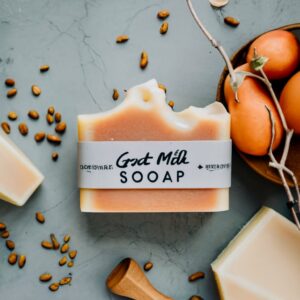
In the world of skincare, goat milk soap stands as a timeless symbol of purity and indulgence. Enriched with the goodness of nature, this soap is a luxurious treat for your skin. Let’s delve into the captivating story of goat milk soap, exploring its benefits, crafting process, and the radiant glow it imparts.
Moisture Magic: Goat milk soap stands as a natural moisturizer, thanks to its rich creaminess. This quality ensures your skin stays hydrated, preventing dryness and fostering a supple texture.
Gentle Cleansing: The mild lactic acid present in goat milk makes it an ideal cleanser. It effectively purifies the skin without stripping away its natural oils, making it particularly gentle for those with sensitive skin.
Nutrient-Rich Nourishment: Bursting with vitamins A, B, C, and D, goat milk provides a nutrient-rich treat for your skin. These vitamins collectively contribute to maintaining a healthy and radiant complexion.
Skin Soothing Properties: Goat milk’s inherent anti-inflammatory properties make it a soothing agent for irritated skin. It proves beneficial for individuals dealing with various skin conditions.
Exfoliation Elegance: Featuring alpha-hydroxy acids, goat milk serves as a natural exfoliant. It delicately removes dead skin cells, promoting a smoother and brighter complexion.
Acne Ally: The antimicrobial properties of goat milk make it a potential ally against acne. By combating acne-causing bacteria, it may contribute to reducing breakouts.
Eczema Relief: Individuals with eczema find relief in the soothing and moisturizing qualities of goat milk soap. It helps alleviate itchiness and irritation associated with this skin condition.
Anti-Aging Elixir: Loaded with antioxidants, goat milk soap combats free radicals, potentially minimizing signs of aging and encouraging a more youthful appearance.
Even Skin Tone: Regular use of goat milk soap can contribute to a more even skin tone, aiding in the fading of dark spots and hyperpigmentation.
Natural Sensation: Free from harsh chemicals, goat milk soap provides a natural and gentle cleansing experience suitable for various skin types.
Softness Unleashed: Infused with shea butter and other emollients, goat milk soap enhances skin softness, addressing issues like dryness and rough patches.
Fragrance Bliss: Enhanced with essential oils, goat milk soap offers a delightful fragrance, transforming your daily cleansing routine into a sensory experience.
Skin-Friendly pH: Goat milk soap maintains a pH level akin to the skin’s, ensuring a balanced environment and preventing over-drying.
Environmental Friendliness: Crafted with natural ingredients, goat milk soap often boasts eco-friendly qualities, minimizing its environmental impact compared to some commercial soaps.
Crafted with Care: Homemade goat milk soaps are crafted with thoughtfully chosen ingredients, adding a personal touch to your skincare routine.
Experience the wholesome benefits of goat milk soap as you pamper your skin with nature’s goodness. Embrace the luxurious feel and nourishing effects for a radiant and revitalized complexion.
Note for goat milk soap recipe
Ingredient Tweaks: Substitute sodium lactate with glycerin or experiment with different carrier oils and essential oil blends for a personalized touch.
Extended Freshness: Enjoy your crafted goat milk soap for approximately six months. Opt for airless pump dispensers to ensure prolonged freshness and minimize contamination risk.
Embark on a brief yet rewarding journey into the world of personalized skincare with your own goat milk soap—a fusion of natural goodness and aromatic bliss for a delightful bathing experience.
Tips for Goat Milk Soap Making
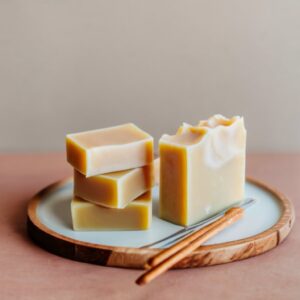
Precision Matters:
Ensure accurate measurements of ingredients using a digital scale for a consistent and well-balanced soap formulation.
Temperature Control:
Keep an eye on temperatures during the soap-making process. Gentle heating and cooling ensure a smooth emulsion.
Prevent Overheating:
Melt the soap base in short intervals to avoid overheating, especially with goat milk, which is sensitive to high temperatures.
Patience is a Virtue:
Allow the soap to cool for a few minutes before adding essential oils. This prevents the volatile compounds in oils from evaporating due to excessive heat.
Emulsification Mastery:
Use an immersion blender to emulsify the soap phases thoroughly. This ensures a well-blended mixture for a uniform and luxurious soap.
Water Compensation:
Account for water evaporation during heating by weighing the container before and after. Add the appropriate amount of distilled water to compensate.
Preservation Wisdom:
Introduce preservatives, such as Geogard ECT, to extend the shelf life of your goat milk soap and prevent microbial growth.
Essential Oil Dilution:
Dilute essential oils properly to prevent skin irritation. A general guideline is around 10 drops per 1 ounce of soap.
Airless Pump Dispensers:
Opt for airless pump dispensers for storage to minimize contamination risk and preserve the soap’s freshness.
Experiment with Variations:
Feel free to experiment with ingredient substitutions and essential oil variations to create a personalized goat milk soap that suits your preferences.
FAQ’S
Is goat milk lotion good for your skin? Goat milk lotion is excellent for the skin. It is rich in vitamins, minerals, and fats, providing moisturization and nourishment. The natural properties of goat milk can soothe and hydrate the skin.
Do dermatologists recommend goat milk soap? Some dermatologists recommend goat milk soap for its gentle and moisturizing properties. It can be beneficial for individuals with sensitive or dry skin, but individual preferences and skin types vary.
Does goat milk lotion need to be refrigerated? Goat milk lotion typically does not need to be refrigerated. However, storing it in a cool, dry place can help maintain its freshness. Refrigeration might be necessary if the lotion contains perishable ingredients.
Does goat milk tighten the skin? Goat milk is not specifically known for tightening the skin. However, its moisturizing properties can contribute to improved skin elasticity, making the skin appear more supple.
Is goat milk lotion good for aging skin? Yes, goat milk lotion can be beneficial for aging skin. Its vitamins and antioxidants may help combat signs of aging, such as fine lines and wrinkles, by promoting skin health and hydration.
Is goat milk lotion good for wrinkles? Goat milk lotion’s moisturizing and nourishing properties can contribute to reducing the appearance of wrinkles and fine lines, providing the skin with essential nutrients.
Can you put goat milk body lotion on your face? Yes, goat milk body lotion is generally safe for the face. However, it’s recommended to check the product’s specific instructions, as some lotions may be formulated for body use only.
Can you put goat lotion on your face? Yes, goat milk lotion is often suitable for the face. It’s important to choose a product specifically labeled for facial use to ensure compatibility with facial skin.
What does goat milk do for your face? Goat milk can provide moisture, vitamins, and antioxidants to the skin, contributing to a healthy and nourished complexion. It may soothe and hydrate the face, making it a popular ingredient in skincare products.
Is goat milk soap good for your skin? Goat milk soap is known for its moisturizing and nourishing properties, making it beneficial for various skin types. It can be particularly soothing for sensitive or dry skin.
Do dermatologists recommend goat milk soap? Some dermatologists recommend goat milk soap for individuals with sensitive or dry skin due to its gentle and hydrating nature. However, recommendations may vary among dermatologists.
What are the disadvantages of goat milk soap? While goat milk soap is generally well-tolerated, individuals with lactose allergies may experience sensitivity. Additionally, some people may prefer the texture and lather of other types of soap.
What is the difference between goat milk soap and regular soap? The main difference lies in the use of goat milk as a primary ingredient in goat milk soap. Goat milk soap is often gentler and more moisturizing than regular soap, making it suitable for sensitive or dry skin.
Why is goat milk soap so popular? Goat milk soap’s popularity can be attributed to its moisturizing properties, richness in vitamins, and potential benefits for sensitive skin. It has gained a reputation for being a natural and gentle skincare option.
Can I use goat milk soap every day? Yes, goat milk soap is generally mild and can be used daily. However, individual skin types vary, so it’s essential to monitor your skin’s response and adjust usage accordingly.
